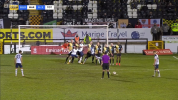Jtpetherick1
Well-Known Member
I think we all understand what a wall looks like, but what actually is one?
I can find no definition in the LOTG about how close players have to be to be in a wall and so on.
In years gone by it wouldn’t have mattered but now with the rule about opponents being close and so on it does.
Do players have to be touching one another? Do they have to be shoulder to shoulder? If so is the man lying behind not part of a wall? Is 30cm apart still a wall?
I can find no definition in the LOTG about how close players have to be to be in a wall and so on.
In years gone by it wouldn’t have mattered but now with the rule about opponents being close and so on it does.
Do players have to be touching one another? Do they have to be shoulder to shoulder? If so is the man lying behind not part of a wall? Is 30cm apart still a wall?






